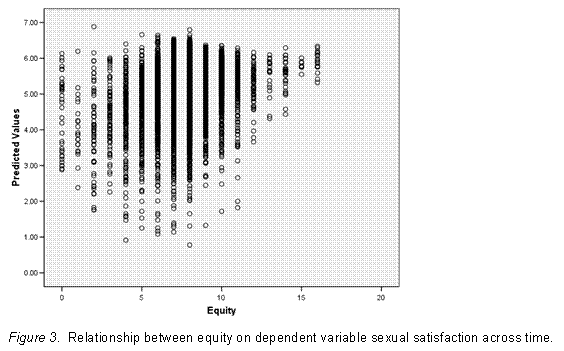
Abstract: Building on previous findings of Equity Theory, which support the premise, that a perception of being “ripped off” result in lower levels of sexual satisfaction, this study poses the question “does time temper the effects of inequality?” Using data from the National Survey of Families and Households, this study examines levels of perceived equity and sexual satisfaction across a fourteen-year period.
Overview
A number of predictive variables (facts) related to sexual satisfaction with few theories upon which to hang these facts
Results in difficulty
Link Between Theory and Fact
Gottman (1999) conceptualizes the research agenda in the area of relationship satisfaction as having two goals.
First, the agenda must focus on good predictive potential of which path couples are on (maintenance or dissolution).
Second, the agenda must be theoretically grounded. Enter Equity Theory.
What Is Equity Theory? (Adapted from Walster, Walster, & Berscheid, 1978)
Proposition One:
People are ego-centric. They try to maximize outcomes (get as much as they can)
Proposition Two (a):
Groups apply pressure to conform
Proposition Two (b):
Part of the pressure is rewarding good behavior and punishing poor behavior
Proposition Three:
If people engage in poor behavior (over or under benefit) they will experience distress.
Proposition 4:
The greater is the inequity the more distress.
Proposition 5:
People attempt to manage the distress by restoring equity.
What We Know about Equity and Relationships
Equity Theory may provide a way to bridge the gap between fact and theory.
What we know about Equity Theory and relationships:
Findings Also Indicate That:
Purpose and Rationale
To apply a social psychology theory of human functioning to a number of predictors associated with sexual satisfaction.
Research Question
Do findings support the theory that suggests as perceived equity moves away from equitable there should be changes in sexual satisfaction and relationship satisfaction?
Sample and Method
Using data from three waves of the National Survey of Families and Households
• 80s, 90s, early 00s
• 13,000 originally sampled
For Each Wave (1-3) the following variables were assessed:
Relationship Equity: Index rang from +8 to +16 with 0=equitable, 4-8 under benefiting, 9-16 for over benefiting. Scored on a 1 to 2 on the following 4 items:
(a) chores
(b) spending money
(c) work for pay
(d) child care
Original Index (Points Assigned)
1. Very unfair to me (+2)
2. Somewhat unfair to me (+1)
3. Fair to both (0)
4. Somewhat unfair to her/him (-1)
5. Very unfair to her/him (-2)
Sum Score - 8 to +8; Rescale 0 to +16
0 – 4 under benefit
8 = equitable
12 – 16 = over benefit
Relationship Satisfaction: One item “how satisfied with relationship” 1-7 scale (1= very unsatisfied, 7 very satisfied). Indicates a “global level” of relationship satisfaction.
Sexual Satisfaction: (two item summed index) how happy and how satisfied w/sexual relationship. Higher Scores indicate “more” satisfaction. Indicates a “global level” of sexual satisfaction.
Additional Variables Used:
Relationship Length
Age
Sex
Income
Analysis
Used multilevel linear modeling to examine the change in equity and the hypothesized associated change in sexual satisfaction across a fourteen year period.
Essentially a complex regression model in which the initial regression model (which is only sexual satisfaction is the only predictor in a model) is regressed onto the second model with the additional non-time varying covariates.
Think of it like this:

Results
Initial descriptive statistics suggests, that in general, the sample across all time periods was generally quite satisfied with their relationship, slightly less, but still rather satisfied with their sexual relationship, and general reported perceiving their relationship as equitable.

Findings generally suggest that for individuals who reported perceived equity closer to “equitable” reported higher levels of sexual satisfaction at the initial time. This relationship did not hold true for the second measurement occasion. However, an individual’s perceived level of relationship satisfaction was related to his or her sexual satisfaction and his or her relationship across time. However, this effect was small in size (r =21). Thus, we can conclude that for individuals in the sample, perceived level of equity was a significant factor in explaining the variation in initial levels of sexual satisfaction as well as in the rate of change over time. Finally, adding the additional covariates in the model (as compared to the unconditional model) helped explain 40 % more variance in the scores.
Discussion
There remains considerable confusion about the linkages between a range of demographic, psychological, and social factors when explaining well-being. This reflects the considerable debate currently raging on genetic environmental and psychological determinants of behavior (Brown, Lent, Ryan, and McPartland, 1996; Diener, 1996; Lykken & Tellegen, 1996). Two findings from the current research suggest important predictors of sexual satisfaction. First, equity was associated, again with a small effect, with sexual satisfaction. Second, race, income, and sex were not found to be statistically significant in their relationship with sexual satisfaction. Returning to Gottman (1993), who called for trajectories of change and maintenance in relationships, the findings permit both researchers and clinicians to gain a better understanding of the relationship life-course across a fourteen-year period examining the influence and change of equity on relationship and sexual satisfaction. Although there is need for future research to examine causal arguments, collectively, the current research findings represent a significant contribution to the literature.
References
Brown, S. D., Lent, R. W., Ryan, N. E., & McPartland, E. B. (1996). Self-efficacy as an intervening mechanism between research training environments and scholarly productivity: A theoretical and methodological extension. Counseling Psychologist, 24(3), 535-544.
Diener, E. (1984). Subjective well-being. Psychological Bulletin, 95(3), 542-575.
Gottman, J.M. (1999). Rebound from Marital Conflict and Divorce Prediction. Family Process, 38, 287-292.
Gottman, J. M. (1993). A theory of marital dissolution and stability. Journal of Family Psychology, 7(1), 57-75.
Lykken, D., & Tellegen, A. (1996). Happiness is a stochastic phenomenon. Psychological Science, 7(3), 186-189.
Walster, E., Walster, G. W., & Traupmann, J. (1978). Equity and premarital sex. Journal of Personality and Social Psychology, 36, 82-92.
Walster, E., Walster, G. W., & Berscheid, E. (1978). Equity: Theory and research, Boston, MA: Allyn & Bacon.
See also:
Ueleke, W., Miller, D., Giesen, M., & Miles, S. (1983). Inequity resolving behavior as a response to inequity in a hypothetical marital relationship. Psychology: A Journal of Human Behavior, 20, 4-8.
Winn, K. I., Crawford, D. W., & Fischer, J. L. (1991). Equity and commitment in romance versus friendship. Journal of Social Behavior and Personality, 6, 301-314.
Walster, E., Traupmann, J., & Walster, G. W. (1978). Equity and extramarital sexuality. Archives of Sexual Behavior, 7, 127-142.
© Cohn, T. J., 2006